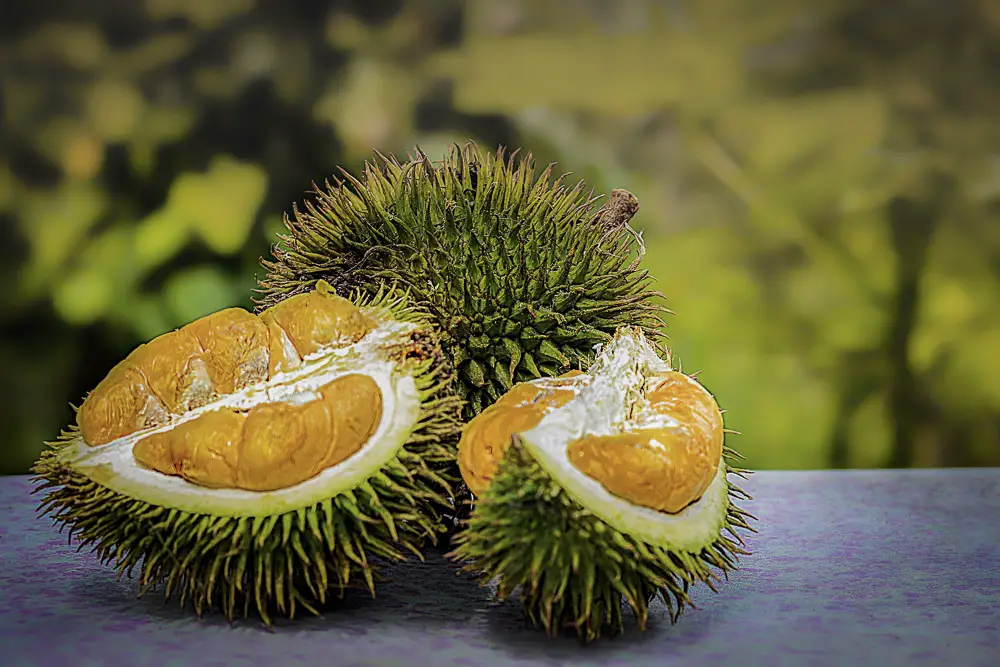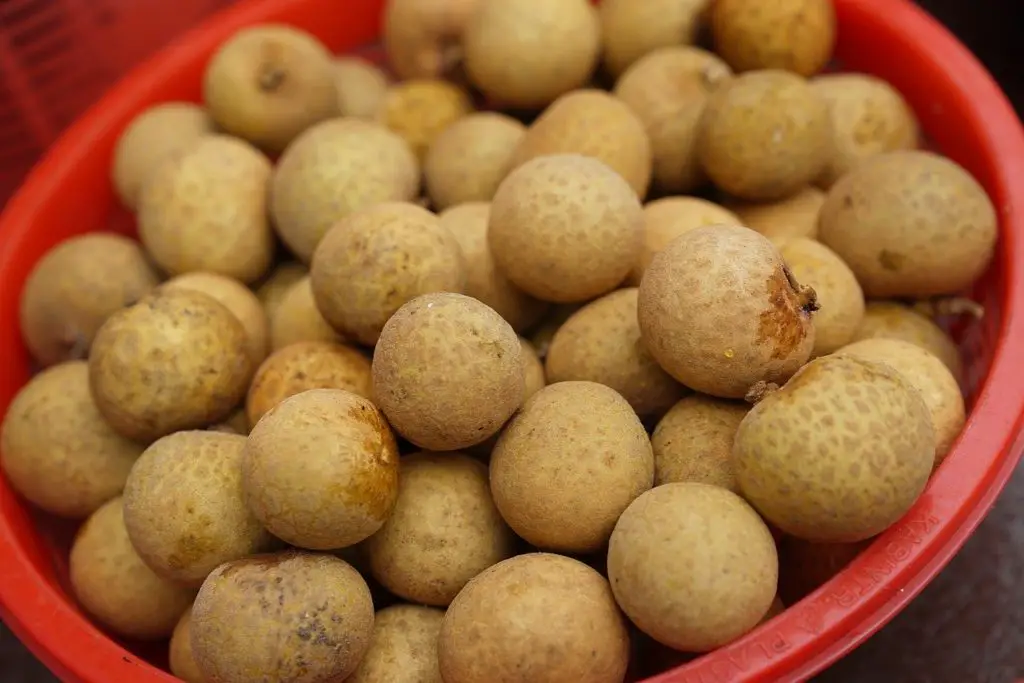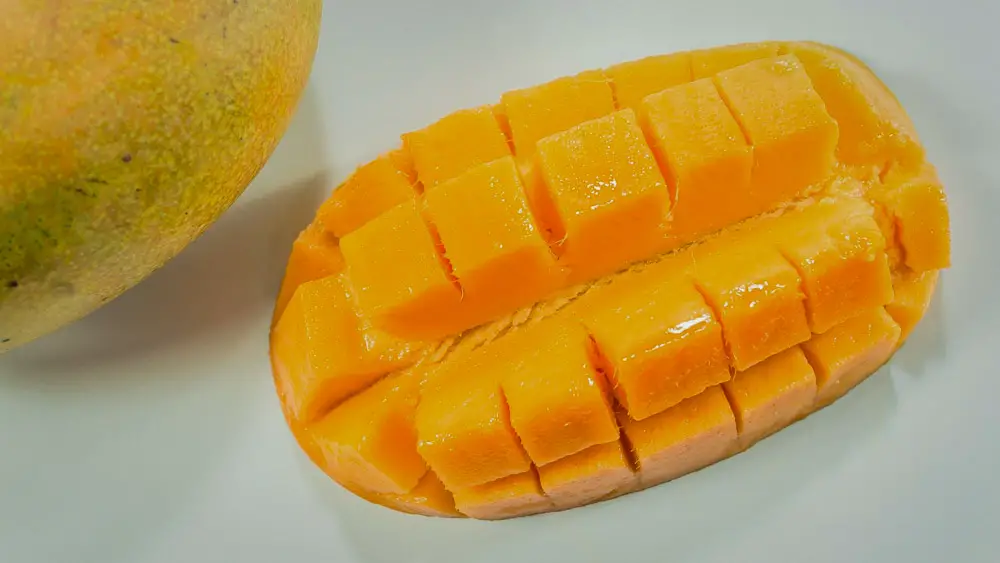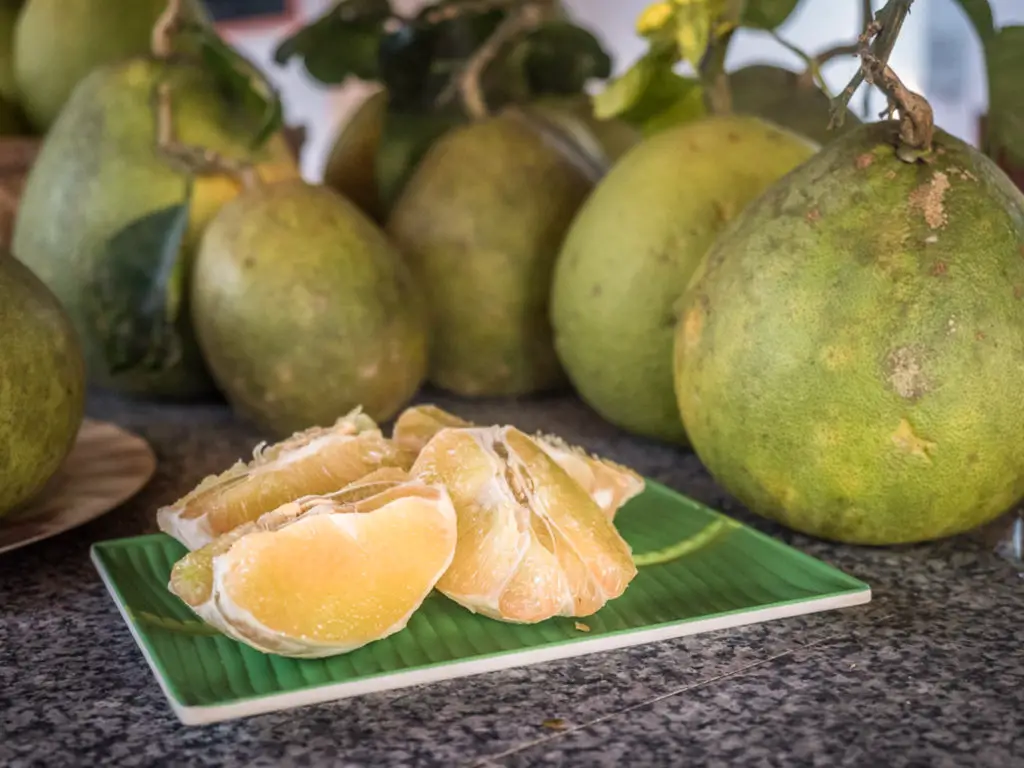As an Amazon Associate I earn from qualifying purchases. Please read the disclaimer for more info.
Embark on a flavor journey as we explore Malaysia’s vibrant and diverse tastes! From sweet and tart to fragrant and juicy, dozens of unique fruits are grown in this tropical wonderland to tantalize your taste buds. This guide will uncover the secrets behind local Malaysian fruits, from durian to starfruit, so that you can glimpse this amazing country’s varied flavors!
Unlock The Taste of 17 Malaysian Fruits
The following list of 17 Fruits of Malaysia is just the beginning of our exploration of the local fruits. When you visit the tropical country of Malaysia, head to a local market to fully embrace the famous fruit.
Durian (Udang Merah)


Durian is the king of fruits in Malaysia, a country known for its diverse culinary offerings.
This exotic fruit with a spiky exterior and creamy flesh is a staple in the Malaysian diet, and locals cannot get enough of it.
With its strong smell, the durian may not be the most popular fruit for everyone, but those brave enough to try it are often rewarded with a unique and delicious taste.
It is not just a fruit but a cultural experience in Malaysia – from selling it on the roadside to cooking it in various dishes, durian is a beloved part of Malaysian identity.
The main durian season runs from June to August, with a shorter season between November and January.
My favorite way to enjoy durian as a refreshing snack is durian ice cream. In particular, I finish most meals with ice cream here at Jalan Alor Night Market.

Snake Fruit (Salak)

If you’re traveling through Malaysia, you must try Salak, also known as snake fruit.
Snake fruit is one of the more intimidating-looking Malaysian fruits, with small, scaly orbs and a tough dark exterior.
But once you crack open that exterior, you’ll find a juicy, sweet fruit well worth the effort.
It’s a little like a cross between an apple and a pineapple, with a slightly tart taste.
Plus, it’s packed with nutrients, so you can feel good about indulging in this tasty treat.
Jackfruit

Malaysia is home to many exotic fruits; jackfruit is one of the most popular.
This tropical fruit can weigh up to 80 pounds and has a spiky, green exterior that gives way to delicious, sweet flesh.
Jackfruit is commonly used in Malaysian cuisine and can be found in dishes ranging from curry to stir-fry.
But it’s not just the taste that makes jackfruit so special – it’s also incredibly versatile.
The seeds can be roasted, boiled, or even turned into flour, while the fibrous flesh can be used as a vegetarian substitute for meat.
Sapodilla Fruit (Ciku)

Sapodilla fruit, also known as Ciku, is a mouthwatering tropical fruit that is widely enjoyed in Malaysia.
This juicy fruit is well-known for its unique caramel-like taste that is truly one of a kind.
Ciku is a small fruit with brown skin, not too dissimilar to a kiwi fruit, that can be peeled off easily to reveal its sweet and succulent interior.
It is perfect for satisfying your sweet tooth, and it’s no wonder why it’s a popular snack among Malaysians.
Mangosteen

The purple mangosteen, the delectable tropical fruit, is one of my favorite fruits and a beloved delicacy in Malaysia.
This sweet and tangy fruit is known for its mildly sweet and refreshing taste with a hint of tanginess.
Locally known as ‘manggis’, it is a staple ingredient in many Malaysian dishes.
The fruit is famous for its unique characteristics as it has a hard exterior and soft, juicy flesh inside that leaves a sweet aftertaste.
Often referred to as the ‘queen of fruit’ in Malaysia, mangosteen is considered a delicious fruit and medicinal one.
For centuries, it has been used to treat a vast range of ailments like fever and reduce inflammation and help regulate blood pressure.
Langsat (Dokong)

Langsat, or Dokong, is a tropical fruit native to Malaysia.
This small, oval-shaped fruit is about the size of a golf ball and has a thin, yellowish skin that is easily peeled.
Once peeled, you’ll find translucent, juicy flesh with a slightly sweet-sour taste.
Langsat is often eaten as a snack or used in desserts and is believed to have medicinal properties.
Related: 15 Delicious Fruits in Bali
Cempedak Fruit

Malaysia is blessed with a diverse range of fruits, and one of the most interesting fruits of Malaysia is the Cempedak fruit.
It’s a tropical fruit native to Southeast Asia and is often confused with the more popular Jackfruit.
However, Cempedak has unique characteristics and slightly different textures, colors, and flavors.
This yellow-orange fruit is known for its strong aroma and can be eaten raw, although it is more likely to be enjoyed as a fried snack.
Some even use it to make cakes and pastries.
Mango

Mangoes are truly a fruit lover’s delight, and there is no better place to enjoy this popular local fruit than Malaysia.
This tropical paradise is the perfect breeding ground for sweet, juicy fruit, and Malaysians have long enjoyed the luscious flavors and unique textures that mangoes provide.
They can be found everywhere, from street vendors selling freshly cut slices to upscale restaurants serving up mango desserts as beautiful as they are delicious.
With so many varieties of mangoes grown in Malaysia, there is always something new to try.
Papaya (Betik)

Papaya, also known as betik in Malaysia, is a tropical fruit that has become a staple in Malaysian cuisine.
With its vibrant orange flesh and sweet, juicy taste, papaya can be enjoyed on its own or used as an ingredient in various dishes.
In Malaysia, papaya is commonly used in salads, curries, and even as a dessert ingredient.
Beyond its delicious taste, papaya is packed with vitamin C, folate, and potassium, making it a great addition to any healthy diet.
Whether you’re looking for a refreshing snack or a versatile ingredient to add to your culinary repertoire, papaya is worth trying in Malaysia.
Read More: 13 Delicious Types of Papaya
Pulasan (Rambutan Kafri)

Have you ever heard of a fruit called Pulasan, also known as Rambutan Kafri, in Malaysia?
This delicious tropical fruit has a spiky exterior, but don’t let that discourage you from trying it.
Once you peel away the prickly skin, you’ll find a pulpy, sweet flesh similar in texture to lychee.
This succulent fruit is native to Southeast Asia and is especially popular in Malaysia during its peak season from June to August.
It’s not only known for its sweet taste but also for its numerous health benefits.
Java Apples (Rose Apple)

Java Apples, also known as the wax apple and water apple, is a delicious fruit that thrives in Malaysia’s tropical climate.
These apples are round, crunchy, and juicy, with a slightly sweet flavor with hints of rosewater.
They are often eaten fresh but can also be used in salads or cooked in dishes to add a unique twist.
Jambu Air is not only tasty but also boasts several health benefits. It is rich in vitamin C and antioxidants, which can help boost immunity and protect against chronic diseases.
Starfruit (Belimbing)

When you think of tropical fruits, starfruit may not be the first to come to mind.
But in Malaysia, it’s a beloved and iconic fruit known as belimbing.
The star-shaped slices are often used in salads or as a garnish, but they’re also delicious eaten raw or cooked.
The fruit is mildly sweet and tangy, with a crunchy texture.
Pomelo (Limau Tambun)

Pomelo, also known as Limau Tambun, is a popular fruit in Malaysia that is loved for its juicy and succulent flesh.
This fruit is one of the Malaysian fruits that are close relatives to other fruit – in this case the grapefruit, which shares the same tangy taste as its cousin.
Its sheer size sets the pomelo apart, with some specimens weighing up to four kilograms!
It is commonly grown in the Tambun Valley, located in Perak, and the locals take great pride in their ability to produce the finest fruit.
For those who love to cook, pomelo can also be added to salads and desserts for a unique tangy flavor that cannot be replicated with any other ingredient.
Guava Fruit (Jambu Batu)

Guava, also known as Jambu Batu, is a beloved fruit in Malaysia that is enjoyed for its sweet and tangy flavor.
It is a popular snack available in local fruit markets and street vendors.
Guava, with its light green exterior, is packed with numerous health benefits, rich in antioxidants, and a great source of vitamin C.
It is commonly eaten fresh in Malaysia but is also used in drinks, desserts, and jams.
One of the unique ways that guava is enjoyed in Malaysia is through rojak buah, a mixed fruit salad topped with a sweet and spicy sauce.
Rose Myrtle – Kemunting

Rose Myrtle Fruits, also known as Kemunting in Malaysia, are tropical Malaysian fruits gaining popularity for its distinct flavor and health benefits.
This small, red fruit is packed with antioxidants and vitamins and is commonly used in traditional remedies, and is said to have healing properties for conditions like asthma and fever.
But beyond its medicinal value, this fruit is also a delicious addition to any dish.
Its tangy, slightly sweet taste makes it a refreshing ingredient in salads, sauces, and desserts.
Longan


Longan, also known as “Dragon Eye Fruit,” is another one of the tropical fruits that are native to Southeast Asia, particularly Malaysia.
This small, round fruit with a hard shell is filled with translucent, juicy flesh that is incredibly delicious.
Longan is a staple in Malaysian cuisine and can be found in many traditional dishes, drinks, and desserts.
Malaysians have been cultivating longan for centuries and are experts at selecting the best quality fruit.
Longan is not only loved for its sweet taste but also for its numerous health benefits.
Lychee

Lychees, also known as litchi, is a delicious and unique fruit that thrives in the tropical climate of Malaysia.
With its spiky exterior and juicy flesh, the lychee is beloved by locals and tourists alike.
The fruit is commonly used in Malaysian cuisine, with popular dishes such as lychee chicken and salad.
The lychee season in Malaysia typically lasts from May to August, and during this time, you can find freshly picked lychees sold in markets throughout the country.
With its sweet and refreshing taste, it’s no wonder that lychee is a staple fruit in Malaysia!
Turn the fruits of Malaysia into a cocktail with this recipe – Sparkling Watermelon and Lychee Cocktail
Summary of Fruits of Malaysia
Whether you are looking for local fruits that taste sweet or enjoy the sweet-sour taste, Malaysian fruits will have something for you.
Related:

